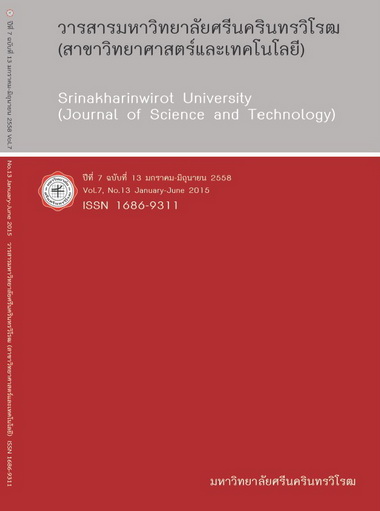การศึกษากากกาแฟและกากชามาใช้ประโยชน์ในรูปเชื้อเพลิงอัดแท่ง (A STUDY ON HOW TO UTILIZE COFFEE RESIDUE AND TEA RESIDUE FOR THE PRODUCTION OF BRIQUETTES)
Abstract
ปัญหากากกาแฟและกากชาที่เหลือทิ้งจำนวนมากส่งผลกระทบต่อสิ่งแวดล้อมอันเนื่องมาจากของเสียเหล่านี้มีองค์ประกอบของสารอินทรีย์อยู่เป็นจำนวนมากจึงไม่สามารถทิ้งได้ โดยต้องผ่านการบำบัดก่อน งานวิจัยนี้จึงได้ศึกษาการนำกากกาแฟและกากชามาผลิตเป็นแท่งเชื้อเพลิงโดยใช้แป้งมันสำปะหลังเป็นตัวประสาน จากนั้นนำมาวิเคราะห์ค่าความร้อน คุณสมบัติด้านเชื้อเพลิง (Proximate Analysis) ตามมาตรฐาน ASTM (American Society for Testing and Materials) ได้แก่ ความชื้น สารระเหย คาร์บอนคงที่ และเถ้า การกำหนดสภาวะอุณหภูมิในการคาร์บอไนเซชัน ผลของการคาร์บอไนซ์ กากกาแฟและกากชาและการวิเคราะห์หาปริมาณธาตุ (ultimate analysis) ที่เป็นองค์ประกอบของเชื้อเพลิง รวมถึงการศึกษาสมบัติทางกายภาพของเชื้อเพลิงอัดแท่ง ได้แก่ การติดไฟ ปริมาณควันไฟ ซึ่งพบว่าแท่งเชื้อเพลิงที่ผ่านการคาร์บอไนซ์กากกาแฟและกากชา มีค่าความร้อนเพิ่มขึ้นจาก 5,517 แคลอรี่/กรัม ไปเป็น 7,460 แคลอรี่/กรัม และกากชาเพิ่มขึ้นจาก 4,482 แคลอรี่/กรัม ไปเป็น 5,600 แคลอรี่/กรัม ตามลำดับ จากการวิเคราะห์หาค่าความชื้น ปริมาณเถ้าและปริมาณธาตุที่มีอยู่ในแท่งเชื้อเพลิงพบว่าอยู่ในเกณฑ์มาตรฐานชีวมวลที่กำหนด และสมบัติทางกายภาพของแท่งเชื้อเพลิงที่ผลิตจากกากกาแฟ สามารถขึ้นรูปง่ายไม่แตกร่วน ไม่เปื้อนมือ ติดไฟง่าย ในขณะเผาไหม้ไม่พบการแตกปะทุและไม่มีควัน ส่วนแท่งเชื้อเพลิงที่ผลิตจากกากชาเมื่อหยิบใช้ไม่เปื้อนติดมือเช่นกัน ติดไฟได้ดี ไม่มีการแตกปะทุ แต่ยังมีควัน เนื่องจากยังมีสารระเหยอยู่ในปริมาณสูงกว่ากากกาแฟคำสำคัญ: แท่งเชื้อเพลิง ถ่านอัดแท่ง วัสดุเหลือใช้ กากกาแฟ กากชาConsiderable amounts of coffee residue and tea residue accumulated in Thailand over the years have caused growing environmental problems, as those wastes contain substantial levels of organic substances which require costly treatment upon their disposal. This study aimed to determine whether coffee residue and tea residue could be practically used to produce fuel briquettes by using starch as a binder. Then, the briquettes were evaluated by examining their calorific values, fuel properties (proximate analysis, based on ASTM standards: moisture, volatility, fixed carbon, and ash), optimal temperatures for carbonization, the results of carbonization, the quantities of their elements (ultimate analysis), and their physical properties (flammability and the amount of smoke). The study found that carbonization caused rises in calorific values of briquettes produced from both coffee residue and tea residue. For those made from coffee residue, the calorific value increased from 5,517 calories/gram (without carbonization) to 7,460 calories/gram (with carbonization). For those produced from tea residue, the number rose from 4,482 calories/gram (without carbonization) to 5,600 calories/gram (with carbonization). The study also discovered that the briquettes had moisture contents, the amounts of ash, and the amounts of fuel elements in the levels acceptable under biomass standards. In addition, the briquettes produced from coffee residue were readily molded, not easily shattered, leaving no stains on hands, easy to ignite, and having neither cracks nor smoke during combustion. The same desirable qualities did apply to the briquettes created from tea residue. However, the latter emitted a fair amount of smoke as tea residue had higher volatility than did coffee residue.Keywords: briquettes, charcoal, unused wastes, biomass, coffee residue, tea residueDownloads
Download data is not yet available.
Downloads
Published
2015-01-02
How to Cite
ตั้งมั่นคงวรกูล น., & ปรีดาสุริยะชัย พ. (2015). การศึกษากากกาแฟและกากชามาใช้ประโยชน์ในรูปเชื้อเพลิงอัดแท่ง (A STUDY ON HOW TO UTILIZE COFFEE RESIDUE AND TEA RESIDUE FOR THE PRODUCTION OF BRIQUETTES). วารสารมหาวิทยาลัยศรีนครินทรวิโรฒ สาขาวิทยาศาสตร์และเทคโนโลยี, 7(13, January-June), 15–26. Retrieved from https://ejournals.swu.ac.th/index.php/SWUJournal/article/view/7347
Issue
Section
บทความวิจัย





